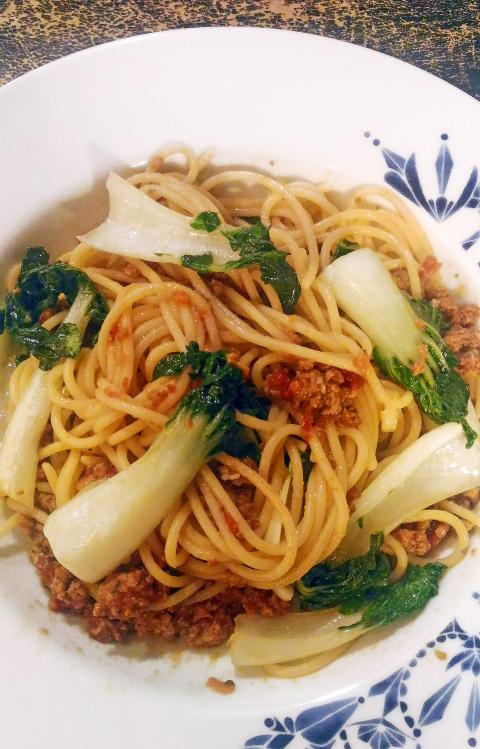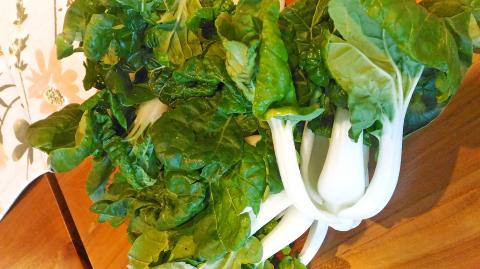It is always nice to discover a new kind of vegetable, especially when it seems to find a place easily in one’s own regular cooking. Most recently I discovered what locals describe as white stem buk choy (牛奶白菜), a firm leafed variety of Brassica rapa chinensis with a thick white stem and a mustardy flavor. The wilted leaves seem perfect for a wide variety of applications, not least as it seems to adapt itself rather well to western cuisine in ways that don’t always work for more established “Chinese” vegetables (see accompanying recipe).
The naming conventions for the many varieties of Brassica rapa chinensis are complex and confusing, not least due to dubious transliterations that sees a number of related but distinct varieties labeled as bak choy (or choi) or pak choy, with English names including Chinese chard and Chinese white cabbage, that do little in the way of providing clarification.
My efforts to find the best name for white stem buk choy led me to the Department of Primary Industries of the New South Wales Government in Australia which, in an effort to provide some level of clarity for the consumer, now distinguishes between buk choy (白菜) and pak choy (青江菜), both staple household vegetables due to their reliable availability and low price.

Photo: Ian Bartholomew
The former has cabbage-like leaves, though more delicate and loose, not bunching into a ball. It has a bland cabbage-like flavor but without the body or crunch of the more homely plant. The latter, in flavor at least, is closer to mustard greens, sometimes with a hint of bitterness. In appearance it is similar to white stem buk choy with meaty stems and firm leaves, though the stems are tinged with green and the leaves are flatter, not crenelated as with buk choy.
Unfortunately, flavor has often been sacrificed to availability in both of these vegetables, and there has been many a time that I have regretted skin-flint tendencies where I have reached for these cheap green leaves to bulk up the veg content of family dinners. White stemmed buk choy, which seems at the moment to be a relatively new cultivar on the market, makes good on this, packing loads of flavor, and looking quite pretty to boot.
White stem buk choy is like getting two vegetables in one, with its thick, juicy stems providing crunch in fried dishes, or soaking up sauces in a braise, while the leaves have a robustness of texture and flavor that works well in warm salads or as part of an ensemble of steamed vegetables. Usually it only takes minutes to cook and once washed can be thrown into the dish at the last moment to work its magic.

Photo: Ian Bartholomew
With a vegetable that is so easy to prepare there really is no excuse not to put it on the table, though one issue with this veg is that it sometimes sports a slight bitterness that some, particularly young children, may find objectionable. The level of bitterness is related to the manner of cultivation, which is now something most consumers have much control over, but purchasing organic or naturally grown buk choy is generally the better option in terms of flavor. Nutritionally, buk choy is also packed with all kinds of good things.
Meat Sauce Pasta with White Stem Buk Choy
Recipe
(serves four)
White stem buk choy is most notable for its robust flavor and crisp stems. Stirring it into a strongly flavored meat sauce adds another layer of texture, and its flavor, with its hint of bitterness, cuts through the meaty sauce with a cleansing freshness. The meat sauce offered below does not have any pretense to be a Bolognese, but it is my family’s go-to pasta dish when time is short and appetites need to be sated. It freezes well for up to a month and I often double or quadruple the recipe to make the most of the long cooking time. The use of an all pork mince, rather than the traditional combination of pork and beef, deprives it of a certain strength of character, but this is perfectly addressed by the inclusion of the white stem buk choy, with its hints of mustard and aggressive personality.
Ingredients
400g pork mince (finely ground)
1 small onion, finely chopped
1 carrot, coarsely grated
2 stems celery, finely chopped
6 cloves garlic, minced
400g tinned chopped tomato
1 tablespoon chopped basil
1 tablespoon dried oregano
400ml red wine
50ml olive oil
salt and pepper to season
2 bunches of white stem buk choy
400g dried spaghetti
Directions
1. First make the meat sauce. This is best done the day before, or in the morning if you are aiming for an evening meal, as the flavors improve with a resting period.
2. Season the minced meat with salt and pepper. Set aside for about 20 minutes.
3. Warm a Dutch oven over low heat and add most of the olive oil. Sweat the onions until translucent, about five minutes. Add the celery and carrot and heat for a further five minutes or until soft.
4. Add the garlic, basil and oregano and continue heating until the vegetable mixture is very fragrant.
5. Add the meat and mix thoroughly, turning the heat up to medium. Continue to cook over medium heat until the meat colors.
6. Add the tomato and mix thoroughly, then add the red wine.
7. Bring to a gentle boil then turn heat down and cover. Simmer over very low heat for two hours. Alternately, if using an oven-proof Dutch oven, put in a pre-heated oven at 140C for four to five hours. Using the oven has the advantages not just of reducing the risk of the sauce drying out and the option of leaving it safely unattended, but the longer, slower cooking produces a softer texture.
8. When ready to serve, put the spaghetti in a large pot of well-salted boiling water and cook for the time recommended on the package.
9. While the pasta cooks, heat a skillet over medium heat. Add a tablespoon of olive oil then put in the white stems of the buk choy. Saute for 30 seconds then add the leaves. Season with salt. Stir until the leaves begin to wilt, about 30 seconds, then turn off the heat.
10. Toss the spaghetti with the pasta then throw in the buk choy leaves. Serve immediately.
Ian Bartholomew runs Ian’s Table, a small guesthouse in Hualien. He has lived in Taiwan for many years writing about the food scene and has decided that until you look at farming, you know nothing about the food you eat.
He can be contacted at Hualien202@gmail.com.
Note to readers:
Due to a scheduling snafu, Taiwan in Time will remain on Sunday. The features section regrets any inconvenience this may have caused.

Following the shock complete failure of all the recall votes against Chinese Nationalist Party (KMT) lawmakers on July 26, pan-blue supporters and the Chinese Communist Party (CCP) were giddy with victory. A notable exception was KMT Chairman Eric Chu (朱立倫), who knew better. At a press conference on July 29, he bowed deeply in gratitude to the voters and said the recalls were “not about which party won or lost, but were a great victory for the Taiwanese voters.” The entire recall process was a disaster for both the KMT and the Democratic Progressive Party (DPP). The only bright spot for

Water management is one of the most powerful forces shaping modern Taiwan’s landscapes and politics. Many of Taiwan’s township and county boundaries are defined by watersheds. The current course of the mighty Jhuoshuei River (濁水溪) was largely established by Japanese embankment building during the 1918-1923 period. Taoyuan is dotted with ponds constructed by settlers from China during the Qing period. Countless local civic actions have been driven by opposition to water projects. Last week something like 2,600mm of rain fell on southern Taiwan in seven days, peaking at over 2,800mm in Duona (多納) in Kaohsiung’s Maolin District (茂林), according to

Aug. 11 to Aug. 17 Those who never heard of architect Hsiu Tse-lan (修澤蘭) must have seen her work — on the reverse of the NT$100 bill is the Yangmingshan Zhongshan Hall (陽明山中山樓). Then-president Chiang Kai-shek (蔣介石) reportedly hand-picked her for the job and gave her just 13 months to complete it in time for the centennial of Republic of China founder Sun Yat-sen’s birth on Nov. 12, 1966. Another landmark project is Garden City (花園新城) in New Taipei City’s Sindian District (新店) — Taiwan’s first mountainside planned community, which Hsiu initiated in 1968. She was involved in every stage, from selecting

As last month dawned, the Democratic Progressive Party (DPP) was in a good position. The recall campaigns had strong momentum, polling showed many Chinese Nationalist Party (KMT) lawmakers at risk of recall and even the KMT was bracing for losing seats while facing a tsunami of voter fraud investigations. Polling pointed to some of the recalls being a lock for victory. Though in most districts the majority was against recalling their lawmaker, among voters “definitely” planning to vote, there were double-digit margins in favor of recall in at least five districts, with three districts near or above 20 percent in